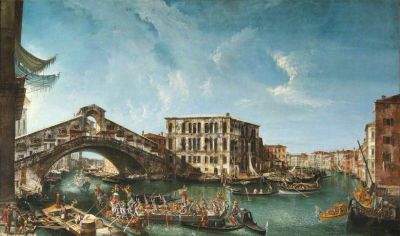This landmark exhibition features magnificent paintings of festive celebrations and newsworthy events from eighteenth-century Europe.
Si è aperta lo scorso 25 febbraio al Museo di Arte di Cleveland la mostra Eyewitness Views: Making History in Eighteenth-Century Europe, una collezione di quaranta straordinari dipinti di alcuni tra gli artisti europei più ammirati, tra cui gli italiani Bernardo Bellotto, Canaletto, Francesco Guardi e Giovanni Paolo Panini. I loro capolavori raccontano con meticolosa precisione una serie di significativi eventi nell’Europa del XVIII secolo. Che si tratti di una processione trionfale, di una gioiosa celebrazione o della catastrofica eruzione del Vesuvio, i colori vivaci e l’attenzione ai minimi dettagli permettono allo spettatore di sentirsi testimone del tempo e parte di queste magnifiche occasioni. Eyewitness Views è la prima esposizione ad esaminare esclusivamente dipinti - fedeli raffigurazioni di un determinato luogo- come rappresentazioni di eventi storici dell’epoca, a cui fanno da sfondo imponenti strutture architettoniche a Venezia, Roma, Parigi, Varsavia e altre città europee. La mostra sarà aperta fino al 20 maggio 2018.
“Eyewitness Views: Making History in Eighteenth-Century Europe” showcases outstanding masterworks by revered artists who recorded some of the most newsworthy events and impressive spectacles of 18th century Europe. Whether depicting a triumphal procession, a joyous celebration or the catastrophic eruption of a volcano, the vibrant, colorful and often monumental paintings in “Eyewitness Views” recreate what it was like to witness these magnificent occasions. Featuring nearly 40 richly detailed master paintings that utilize the impressive monuments of Venice, Rome, Paris, Warsaw, and other European cities as a backdrop, “Eyewitness Views” is the first exhibition to exclusively examine view paintings—faithful depictions of a given locale—as representations of contemporary (18th century) historical events. While costumes and customs illustrated in the paintings may differ from those of today, the feelings of anticipation and excitement generated by witnessing a momentous event will resonate with every visitor to this beautiful and historic “time capsule” exhibition.
“‘Eyewitness Views’ provides our visitors with a wonderful opportunity to experience history as it was being made,” said William Griswold, director of the Cleveland Museum of Art. “The large-scale, vibrantly detailed paintings in the show will transport viewers to 18th century Europe, immersing them in the most elaborate celebrations, festivals and historical events of the time.”
-
 The Bucintoro at...
The Bucintoro at...
The Bucintoro at...
The Bucintoro at...
-
 View of the...
View of the...
View of the...
View of the...
-
 The Nocturnal Good...
The Nocturnal Good...
The Nocturnal Good...
The Nocturnal Good...
-
 The Giovedì Grasso...
The Giovedì Grasso...
The Giovedì Grasso...
The Giovedì Grasso...
-
 The Interior of...
The Interior of...
The Interior of...
The Interior of...
https://www.lagazzettaitaliana.com/local-news/8747-the-cleveland-museum-of-art-presents-eyewitness-views-making-history-in-eighteenth-century-europe#sigProId6881118665
Regularly commissioned by rulers, princes, ambassadors, and religious dignitaries to commemorate key moments in their personal and professional lives, master view painters such as Bernardo Bellotto, Canaletto, Francesco Guardi, and Giovanni Paolo Panini recorded events ranging from the spectacular pageantry of a Venetian regatta to the solemn ritual of a religious procession. In the process, they produced some of their most significant and beautifully detailed works. Dramatically staged for the enjoyment of a wide range of spectators and typically involving sumptuous costumes and elaborate temporary decorations, the events depicted give the viewer insight into the rituals and rare occurrences of a bygone era. Other paintings document some of the era’s most horrific natural and man-made disasters: fires and volcanic eruptions provided particularly compelling imagery.
“The level of detail in these paintings can be astounding. To please their patrons—who had often paid for both the celebration depicted as well as the painting of the event—artists like Panini and Canaletto precisely documented the most minute elements of personality, costume and décor. Other artists excelled at conveying all the energy and atmosphere of an important festival or ceremony. Sometimes artists were confronted with the challenge of painting an event that they did not personally attend. This exhibition helps viewers understand the various ways artists addressed such challenges,” said Marjorie E. Wieseman, the Paul J. and Edith Ingalls Vignos Jr. curator of European paintings and sculpture, 1500–1800, and chair of European art from classical antiquity to 1800.
“Eyewitness Views: Making History in Eighteenth-Century Europe” is co-organized by the Cleveland Museum of Art, the J. Paul Getty Museum and the Minneapolis Institute of Art and is on view in the Kelvin and Eleanor Smith Foundation Exhibition Hall from February 25 through May 20, 2018.
Tickets: Adults $12; seniors and college students $10; children 6–17 and member guests $6; 5 and under and CMA members free.



